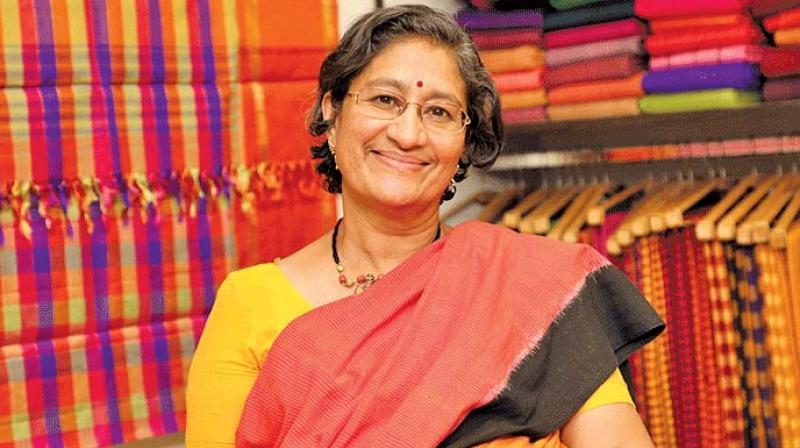Pavithra, saving a culture, weaving better life for artisans
Pavithra attributes her passion for textiles and handlooms to her father, B C Nanjappa’s encouragement and her mother’s interest in it.

The spinning wheel has a particularly sentimental and even patriotic significance for the country. Paying it homage in her own style is Pavithra Muddaya who has for decades worked to preserve India’s culture and weaving tradition along with securing the livelihoods of the weavers themselves. Besides founding Vimor, a commercial enterprise specialising in handlooms, she is also writing a book on the weaving traditions of the country and has established a museum in Bengaluru to tell the stories of weavers before they are forgotten. Vishaka V Warrier reports
A passion for preserving the country’s culture and weaving tradition has seen Pavithra Muddaya evolve into a textile historian and designer. Co-founder of Vimor, a commercial entity that has been engaged in reviving and selling handloom sarees for the past 45 years, while also securing the livelihoods of the many weavers it employs, she recently established a living museum in Bengaluru to share stories of weavers and weaving from over the decades.
Although she currently works with weavers from Chitradurga, Gadag, Bagalkot and Mangaluru in Karnataka, in addition to some from Tamil Nadu, Andhra Pradesh, and Rajasthan, Pavithra says, “Looms have no language and I am not confined to any community or district. I have worked with mostly individual weavers, who have approached me.”
Attributing her success mainly to the goodwill of the weavers she employs, she explains,. “I give them the design, colour, and so on and they produce the material for me . But at Vimor we try to secure the weavers’ contribution, paying them an amount as advance, along with the option of complete buy back. This insulates them against risk and all through the journey of weaving, they get their earnings.”
While she is convinced that handlooms can never die in India, she is trying to preserve the weaving history of the country in a book that shows how inter-twined our lives are across its vast expanse.
“The book talks of how weavers migrated. bringing different design elements to the places they settled in. Most of the time, it is believed that certain designs are confined to a certain region. But what I want to present is the association of migration, trade and inter-marriages, with weaving. We have a Manipuri pallu done in Karnataka and an ilkal saree from Benares. There is so much in common across India that it is brilliant,” she says.
To put it simply, Pavithra’s hope is to celebrate commonality instead of upholding differences and textiles embrace this mantra beautifully, she finds.
“Handlooms in India will never die. There is no question of it, even if certain designs are subjected to testing times. Handlooms and designs are everyone’s common inheritance. It is very necessary to take pride in it. We are moving so fast with respect to trends in aesthetics that it is necessary to document and preserve the ancient cultural designs and also to educate the newer generations about their inheritance,” she adds with strong conviction
Pavithra attributes her passion for textiles and handlooms to her father, B C Nanjappa’s encouragement and her mother’s interest in it. Chimmi Nanjappa was the first manager of the Cauvery Arts and Craft Emporium in Bengaluru, which at the time also specialised in handlooms. She was selected to participate in international textile fairs in the sixties by Pupul Jaykar , an iconic woman, who worked to revive the textile industry. As her employers did not agree to send her to the fairs, she quit her job to go to them and there was no looking back.
Years later, Chimmi set up Vimor with her daughter, Pavithra with the backing of the likes of social reformer and freedom fighter, Kamaladevi Chhattopadhya and Pupul Jayakar .
It was only a two months’ course at the Weavers Service Centre in the city that laid the foundation for Pavithra’s later expertise in the field. Taking baby steps with traditional simple designs, she went on to create an identity as a textile revivalist and historian as the years progressed.
The living museum which is her latest project, is only one- and- a- half months old and is a journey through the ancient forgotten weaves of the country. “The living museum of textiles takes each of its visitors through the contributions of weaving done by and for the common man. It narrates the tale behind each saree in the presence of the weavers,” she explains.
Making no bones that handlooms and textiles are her passion, she says, “ I enjoy documenting the old designs and also recreating them by employing my own aesthetic sense. The re-creation ensures there is no stagnation of any design.”
Just as Vimor means “pure,” so is Pavithra’s mission, which she describes as “Going beyond caste, region and community, to preserve ancient handloom designs along with providing livelihood options for the needy.”

